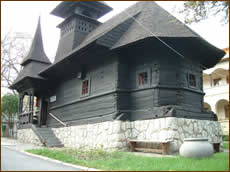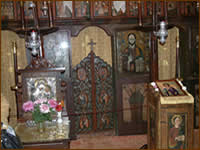"Saint Mary" Monastery
|
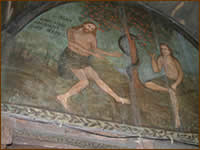
Adam and Eve with the snake |
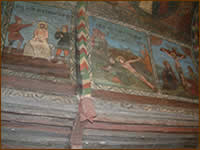
The Passion of Christ |
Thus, the naive style of the anonymous artist peasants and the refinement of a belated romanic picture are combined in one place. It's one of the rare wooden churches which totally kept its picture and which holds the spirit of Romanian peasants from Transylvania in the middle of Dobrogean places.
On the premises of the monastery, there is a building for the superior clergy - built in 1953 - where the 6th "Interconfessional ecumenic dialogue" took place in 1985. In the same perimeter there is the fountain with Saint Pantelimon's statue, sculpted in bronze by the famous Romanian sculptor Ion Jalea, and brought here by Patriarch Justinian, from Bucharest, from the "Saint Panteleimon" hospital. This saint lived in the 4th century in the Roman Empire, under Maximia's rule, and he was a famous physician who became a miracle worker, with the gift of healing all kind of diseases - after becoming a Christian. After having worked many miracles, he was caught and martyrized. The Church honours him as a martyr and a "freely of charge physician", being the protector and the patron of medicine. Symbolically, his statue was placed in the park of the clergy home that had 'Saint Panteleimon' its feast day for the protection of those who would come here for treatment.
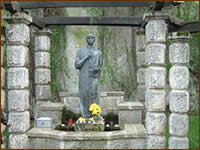
Saint Pantelimon Fountain |

Fountain fresco |
In order to continue the curative activity at the monastery, in 1999-2000 a balneary treatment base spa was set up - under Saint Panteleimon's protection - equipped with electrotherapy medical instruments, galvanic and saline baths, sauna, and all the necessary endowment, etc.
With the support of the National History and Archeology Museum of Constanta, and the kindness of that time's Director Prof. Dr. Adrian Radulescu, in 1989-1990 a museum was set up on the monastery's premises: "Evidence of Christian life on Dobrogean lands" - museum which displays archeological fragments and religious cult objects from the 4th century untill today. Amongst the most valuable pieces, we mention: fragments of Christian churches from 4-6th centuries found at Tomis and Calatis; Roman-Byzantine amphora dated from the 6th century; fragments of ceramics with Christian symbols on them, dated between the 4th to the 11th centuries;archeological fragments coming from the monastic complex of Basarabi, digged in a chalk hill that is dated in the 9th century - a proof of the long Romanian monachal tradition - and a lot of religous cult objects dated from the 18th and the 19th centuries (icons, vestments, robes, golden bowls, etc.).
Between the years of 1969 and 1990, the monastery hosted the yearly courses for the guides and the museographs from churches all over the country - except from Moldavia. Important people of the Romanian culture - such as Prof.Dr.Zoe Dumitrescu-Busuleaga, Prof.Dr. Adrian Radulescu, Prof. Dr. Ioan Curinschi, P.C. Prof. Pacurariu, Prof. Dr. Constantin C. Giurascu and others - brought a high degree of proffessional competence to these courses. The courses were stopped in 1990, being starting re-started in 1999 at the intervention of the Ministry of Culture and Cults.

Enclosure of the Monastery |

Bishop's House Alley |
As the number of the monastic community grew substantially, in 1995 the "Saint Mary" hermitage was tranformed into a monastery with juridical statute, under the patronage of "The Dormition of our Most Holy Lady the Mother of God and Ever-Virgin Mary". Today, the monastery has 43 nuns who combine prayers with various artistic and householding activities. Thus, a painting workshop, where the nuns paint icons in tempera technique, paint eggs, make rosaries, book signs - and the list can continue, etc. During summer, the monastery provides hosting and food for the Christians and those who wish to spend their vacations, offering the possibility to take a balneary treatment, beneffitting from modern equippment and proffessional assistance.
The little wooden church as a historical monument needs special care and because it is too small for both the monastic community and the Christians who attend the holy services, His Beatitude Patriarch Teoctist has stuck the cross for the construction of the new church that will be built in concrete and will celebrate the same feast day "The Dormition of our Most Holy Lady the Mother of God and Ever-Virgin Mary".
Finally, here is how the Minister of Tourism valued our Monastery when he was visiting it in 1990: "We do have a lot of beautiful things here on the seaside, but what you, the nuns, have here, we do not."

© Copyright 2005 - 2024, Saint Mary Monastery-Techirghiol. All rights reserved.
webdesign by Graffco


